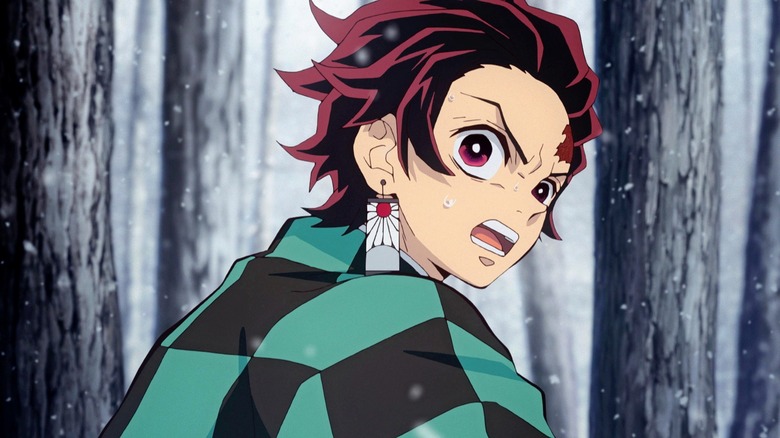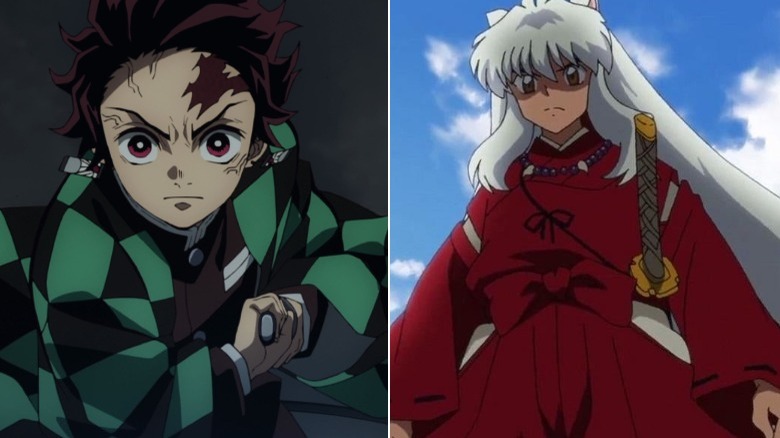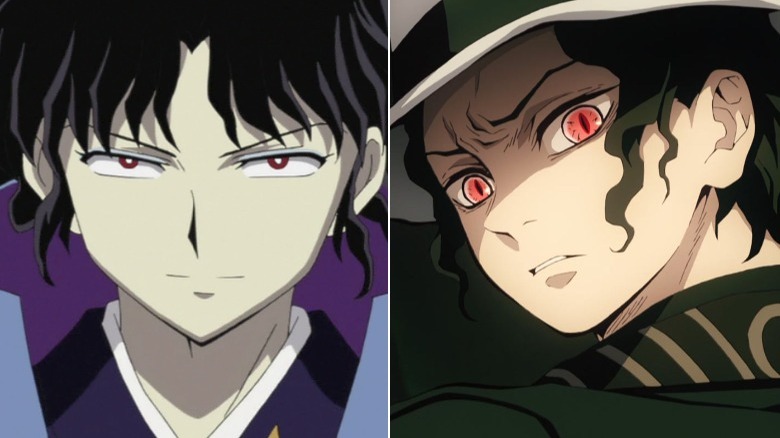The Classic Anime That Influenced Demon Slayer
In the immensely popular anime series "Demon Slayer," a young boy named Tanjiro has his life irrevocably altered after a demon slaughters his entire family — except for his little sister. He soon sets out on a quest to join an elite group of — you guessed it — demon slayers in the hopes of curing his demon-infected sister. Along the way, he befriends two fellow new recruits, who join him in fighting off some dangerously elite demons, which all builds up to an epic battle with the biggest, baddest demon of them all.
Does any of this sound familiar? On the surface, these are the building blocks for pretty much every battle-shonen anime out there — a tragic motivation, a lifelong mission, a group of friends, and some enemies to act as stepping stones to the monster at the end of the road. Drawing comparisons between "Demon Slayer" and other contemporary shonen hits is easy because when it comes to the big stuff, they have a lot in common. Heroes slaying demons so humanity can persevere? Sounds like "Black Clover." Or "Jujutsu Kaisen." Or "Blue Exorcist" — the list goes on. But what's much more fun is noticing all the small details that two shows share in common, like the many threads linking "Demon Slayer" to a beloved classic anime, "Inuyasha."
Okay, so the similarities between the two series may not be immediately clear: "Inuyasha" is an Isekai and a love story. The series follows a schoolgirl down a well that doubles as a portal to the past, where she teams up with a hybrid dog-demon/human to collect the shards of a wish-granting jewel. Unlike "Demon Slayer" which moves at a brisk, focused pace, "Inuyasha" meanders like its plot is nobody's business and spans a whopping 167 episodes. So what exactly do "Inuyasha" and "Demon Slayer" have in common? Y'know, besides the prominence of those pesky, life-threatening demons?
The answer is a lot more than you might imagine.
Demon-slaying swordsmen, unite!
First off, audiences just can't get enough of screaming feudal warriors slashing their giant swords to take down the vicious demons! Inuyasha and Tanjiro both spend much of their time engaged in epic battles, and though they prove themselves strong very early on, they still have a long way to go before they can face the powerful demons they hope to defeat. Another thing they have in common is their ridiculously powerful sense of smell: Inuyasha has a pretty solid excuse, as a half dog-demon. It makes sense for him to have his nose to the ground, sussing things out like a walking compass. As for Tanjiro, his sense of smell just happens to be one of the special skills that he discovers while training to join the Demon Slayer corps. He can smell traps, demons ... and emotions. It's best not to question why.
Then there's that goddamn heroes' spirit. No matter how much easier it would be to give up, Tanjiro is grounded by the memory of his family and the thought of what he's fighting for. It keeps him going in even the direst circumstances. Seriously — even if it means breaking his sword and body in the process, Tanjiro finds a way to scrape himself up from the dirt. Meanwhile, Inuyasha gets in touch with his humanity through Kagome — and always picks himself back up with her in mind. In his worst moments, his friends fear he will succumb to his demon-half, but the good ol' human spirit always wins out in the end.
But enough about the perseverance of humanity, let's talk demons!
A murder of demons
Many have noticed a resemblance between the Big Bad demons, Naraku and Muzan. They share piercing red eyes, wavy black hair, an ongoing air of mystery, and an army of top-tier demon henchmen. They also hold their own generational grudges against their respective protagonists and are in search of a magic MacGuffin that promises to make them immortal. Thus, they set up very similar adventures for their heroes: both Tanjiro and Inuyasha's squads must plow through their demon minions, who turn out to be pretty challenging adversaries, which helps ready them for the final confrontation.
Both series are also set in worlds that blend supernatural and modern aesthetics with the historical influence of feudal Japan. In "Inuyasha," the feudal setting is a world that Kagome literally falls into, which whisks her away from modern Japan to a world filled with monsters, demons, and magical artifacts. Meanwhile, "Demon Slayer" is set in Japan's Taisho era, but when our characters arrive in a city, they're met with a modernized aesthetic: kimonos, business suits, and all. Oh, and it's infested with demons, of course. With all the demons that these shows have running around, there's bound to be plenty of resemblence: like the spine-tingling spider demons that appear in both series, or the creepy white-haired villain children who also happen to be dangerous puppet wielders.
Perhaps some of these commonalities just boil down to coincidence or the plain fact of sharing a genre, but that doesn't mean their connection isn't meaningful. The popularity of "Inuyasha" has persisted so strongly that 20 years after premiering came its sequel series, "Yashahime: Princess Half-Demon." Meanwhile, "Demon Slayer" has blown up so significantly since its release that the movie version of its Mugen Train arc smashed box office records in Japan and unseated Hayao Miyazaki's Oscar-winning "Spirited Away" as the highest-grossing movie in Japan. This feat took many by surprise but looking to the success of "Inuyasha," it makes perfect sense that "Demon Slayer" has thrived: clearly, people are falling over themselves for magical, demon-infested anime about the triumphs of the human spirit.


